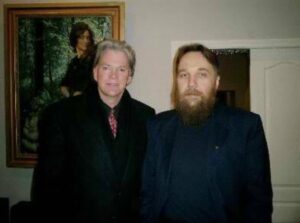
Former head of the Ku Lux Klan, David Duke, with Putin’s ‘fascist brain’, Alexander Dugin, discussing how to save the White race
According to Russian president Vladimir Putin:
“The United States continues to receive more and more immigrants, and, as far as I understand, the white, Christian population is already outnumbered … White Christians have become a minority, less than 50 percent now. … Russia is a vast territory, from its western to eastern borders, it is a Eurasian space. But as regards culture, even language group and history, this all is undoubtedly a European space, as it is inhabited by people of this culture. … we have to preserve all this to remain a significant centre in the world.”
Putin’s appeal to “great replacement” theory, his dog-whistle to the “White Christian” world that must be “preserved” lest it become a minority, demonstrates the clear ideological basis of Putin’s status as demi-God to the global far-right, fascist, Nazi and white supremacist movements.
Here’s what David Duke, former leader of the Ku Klux Klan, had to say when leaving Russia after his five-year sojourn there:
“In this holy cause we must share one immutable principle: all people of European descent, no matter where they reside in the world, are brothers. … Russia has always been a bulwark to the East, the frontier of our race, and it is now on the frontline of our current struggle. It is my prayer that Mother Russia be strong and healthy, may Mother Russia be free; may she always be White. When a racially aware Russia and reawakened America become united in our cause, the world will change. Our race will survive and together we shall go to the stars!”
Years later, exploding with joy following former US president Trump’s chummy press conference with his good mate Putin in Helsinki in 2018, Duke lavished praise on Trump and Putin, believing his wish had come true: “Bravo Trump! Bravo Russia! Russia has values America once had and America the values that Communist Russia had!”
Similarly, French far-right leader Eric Zemmour claims Putin “restored the state,” “stepped in as the last defender of the Christians of the East”, “defends national sovereignty, the family and the Orthodox religion”, contrasting this to liberal, multicultural French politics.
This may be confusing to some who have recently heard that Putin claims he wants to “de-Nazify” Ukraine by bombing it to bits; propaganda can be quite creative. Perhaps more confusing is that there are fascists and Nazis among the vast array of political forces in Ukraine resisting Russia’s imperialist invasion today and intervention in Donbas earlier.
But these are the inherent contradictions of fascism; always based on extreme nationalism and racism, it is near impossible for fascists to collaborate when their “great nations” are in conflict. Try to imagine a collab between Greek and Turkish fascists, for instance.
Not that we should underestimate the malevolence of the Ukrainian fascist forces; we will come to that below. But as we will also see, they are virtually an anomaly in today’s global fascist climate where to be anti-Putin is a non-starter; virtually the entirety of fascist, Nazi, white-supremacist and ultra-rightist forces everywhere in the world have been strongly aligned to the Putin regime; while the political and military forces Russia has installed in the Donbas region of Ukraine are also overwhelmingly fascist. Anyone considering taking seriously Putin’s rhetoric about “de-Nazifying” anywhere should read on for a reality check.
Material basis of Russian imperialism’s alliance with global fascism
The ideological basis of the alliance demonstrates that it is not simply a matter of expediency as sometimes suggested (eg, that Putin’s alliance with European fascism only represents a convergence of interests against the European Union). Nevertheless, this ideological alliance does relate to the concrete material interests of Russian imperialism as it challenges established imperialist powers.
While it is overblown rhetoric to compare Putin’s authoritarian regime, with its parliamentary façade, and its savage litany of crimes against humanity, to Hitler’s totalitarian dictatorship and the Holocaust, this does not mean there are no parallels. German imperialism had been the loser of WWI, and the victorious ‘Allied’ imperialists imposed the winner-take-all Treaty of Versailles on Germany. The rise of extreme German nationalism embodied in Naziism reflected the struggle of the weaker, defeated, imperialist Germany, alongside weaker Italian and Japanese imperialism, against the dominant imperialist powers of the day. These weaker powers had to rely on direct conquest – unnecessary for British and French imperialism which still owned all the world they had earlier conquered, or US imperialism whose economic hegemony was growing. Extreme reactionary ideologies glorifying the mythical past as the ruling class crushes the masses while mobilising them for military conquest with nationalist, racist and militarist slogans fitted well with the needs of these powers.
In broadly similar fashion, the Russian ruling class emerging from the wreckage of the USSR, now heading a smaller Russian Federation, saw itself as ‘defeated’, given the effective domination Russia had exercised over the USSR. While the USSR was not conceived of as an empire, for the reactionary oligarchic elite that arose on the ashes of ‘communism’, the independence of the non-Russian republics was seen as “loss of empire,” and the mythical past of the ‘Great Russian Fatherland’ of the Tsarist Russian Empire extolled as something to aspire to. Of course, there was no unequal treaty a la Versailles imposed on Russia; while the massive immiseration of the Russian working class was imposed by the dictates of the International Monetary Fund and other western state-connected privatisation ‘experts’, the Russian oligarchy was completely complicit in this gigantic plunder, indeed it was its main beneficiary. However, the economic collapse this partnership-in-plunder led to could domestically be blamed on “the West” alone, as a propaganda device to deceive the masses. While I have argued elsewhere that ‘NATO expansion’ cannot be blamed for Putin’s aggression, in the big picture the retention of a US-led, Cold War relic like NATO, as opposed to a new pan-European security architecture, was a further factor that could be used to harness a new Russian nationalist world-view as the rising capitalist elite around Putin strove to overcome its humiliation and strike out as a new, relatively weak, imperialist power.
The strategic orientation of this new Russian imperialism consisted of a number of planks.
The first, more long-term, was embodied in its far-right ideology of ‘Eurasianism’, the idea of uniting Europe and Asia under Russian leadership, which would entail a defeat of off-shore US imperialism and its current hegemony in Europe. Russia, in other words, as the connection between Europe and China; since the turn of the 20th century, geopolitical strategists from the US, Europe and Russia have seen dominating ‘Eurasia’ as key to world domination. In many ways, one could argue this was slowing occurring; Russia’s domination of natural resources, especially oil and gas, and the pipelines, connected it to energy-hungry European and Chinese imperialism as the grand centre. To some extent this dovetailed with the Franco-German imperial project of a Europe more independent of US imperialism; French and German opposition to Ukraine joining NATO, the Russian gas pipeline to Germany, the active diplomacy they engaged in with Russia and Ukraine to prevent war, contrasted to the more confrontational US approach; for the US, avoiding this EU-Russia imperial consortium had been a strategic aim since the end of the Cold War. Beefing up NATO was a major tool of this US strategy, because providing “security” to European imperialism is the main way the US has continued to exercise hegemony there.
Yet how does this Eurasian conception relate to the second leg of Russian imperial strategy – the tendency of the emerging weaker imperialist power to rely more on traditional imperialist methods of direct conquest, straight land grabs, similar, in some way, to weaker German, Italian and Japanese imperialism in the 1930s? Again, Russian imperialism doesn’t possess the global economic hegemony exercised by US and European imperialism, or that China is gaining. This difference should not be exaggerated; the absurd western rhetoric about Putin overturning an imaginary “rules-based international order” is too laughable to require comment; obviously conquest was a past staple of western imperialism, while Russian imperialism has also quietly expanded economically. But the relative difference has become sharper over Ukraine. Obviously one could point to the criminal US invasion of Iraq to highlight the hypocrisy of current western propaganda, but not only was the sheer hubris of this war widely seen as the onset of decline of US global hegemony, but the argument here is not about levels of morality or invasions and violations of international law as such; the US of course is highly “revisionist” on these issues. Rather, the issue if one of formal territorial conquest/annexation as a characteristic of emerging Russian imperialist expansion, which the US has no need for and which even Iraq did not concern.
Yet by invading Ukraine (rather than just Crimea and Donbas, or small parts of Georgia and Moldova), Putin has destroyed the more gradual advance of the Eurasian project; NATO, and US “security” hegemony over Europe, is now more solid than for a generation, and Russia’s European links have been destroyed, symbolised by Germany’s abandonment of Nordstream. While obviously this is the result of catastrophic miscalculation by Putin, it also signifies a limitation of the Eurasian project in its gradualist form: while domination of oil and gas gives Russia bargaining power, in economic terms it means Russia remains eclipsed as the ‘second world’ natural resource supplier of more powerful European and Chinese imperialism. A revanchist Russian Empire, however, drunk on past glory, and its outsized role as the world’s second largest military power, envisages itself as the leader, the centre, of Eurasia. Therefore, asserting its military superiority was important to its “credibility”; it wasn’t going to allow a third world country like Ukraine to demonstrate any independence from the Fatherland. According to professor Jane Burbank, Ukrainian sovereignty was always a problem to ‘Eurasianist’ ideology, one ideologist calling it a “huge danger to all of Eurasia”. Russian leadership of Eurasia required Russian-led unity of the three ‘core’ ex-Soviet states (Russia, Ukraine, Belarus), and, as a minimum, control of the north coast of the Black Sea. The Black Sea is full of hydrocarbons, as well as being a strategic waterway, which Russian imperialism did not plan to share with its former colony.
As such the seizure of the Black Sea coastline from the recalcitrant child represented economic, political, military-gendarme, ‘credibility’ and nationalist-ideological objectives at once.
Given these specific needs of the weaker, emerging imperialist power, and its ideological emergence from alleged “national humiliation”, it is logical for the deeply reactionary, revanchist regime to cultivate ties to other extreme right, fascist parties around the world, which can act in Moscow’s interests by challenging the western imperialist leaders from the right without challenging the same capitalist system they are all part of. Not unlike the role of western fascist parties as allies of Nazi Germany or fascist Italy.
A third dimension of Russian imperial strategy has been to strike out beyond the former Soviet sphere, to exert power in regions such as the Middle East and Africa; the intervention of the Russian air force on the side of Assad’s genocidal regime has been the most prominent, alongside a smaller scale intervention in the Libyan civil war, and support for various African dictatorships’ military and ‘security’ needs, via the Wagner paramilitary. These armed interventions accompany growing Russia economic penetration, even if at a far lower level than western or Chinese capital; in Syria, Russia grabs significant parts of the economy while entrenching itself in vital infrastructure such as ports and bases.
While the plunder of Syrian resources as ‘compensation’ for aiding Assad is old gunboat-style imperialism, Russia’s gendarme role in aiding the regional counterrevolution has been appreciated by the US and its regional allies, especially Israel and the Gulf monarchies. Given the sharing of Syrian air space with the US air force (which bombed ISIS as Russia bombed the anti-Assad rebels), the Russian role had more a ‘sub-imperial’ character, rather than that of ‘imperial rivalry’ with US imperialism. But the war also entailed a Bush-Cheney-style “war on terror” Islamophobic ideological construct that was very attractive to the global far-right, who almost universally saw the Assad regime as a defender of “western civilisation” against “Islamic barbarism,” the ideology espoused by the Syrian regime itself. So Assad was another key connection between Putinism and global fascism.
Alexander Dugin: Putin’s fascist brain
The alliance between Putin’s far-right, uber-nationalist ‘United Russia Party’ and global fascism should already seem obvious from an ideological perspective; but in any case, relations are also mediated by an unabashed leading Russian fascist, Alexander Dugin, “former adviser to Sergei Naryshkin, a key member of Vladimir Putin’s United Russia party who was appointed Russian foreign intelligence chief in 2016.” Dugin’s Foundations of Geopolitics – which advocates his Russian-led ‘Eurasianist’ empire “from Dublin to Vladivostok” – is “assigned to every member of Russia’s General Staff Academy.”
According to one source, “Gestated in anti-communist right-wing activism during the waning days of the Soviet Union, indebted to a specifically anti-liberal and anti-Enlightenment philosophical embrace of authoritarianism, irrationalism, and hyper-nationalism, Dugin dreams of a reborn Orthodox Tsarist state surpassing the borders and spheres of influence as they existed before 1989, of a Novorossiya built not on socialist principles, but fascist ones.” In fact, he criticises traditional fascisms in his 1997 book, Templars of the Proletariat, for moderation; by contrast, in Russia there will emerge a truly “fascist fascism.”
In Foundations of Geopolitics, Dugin asserts that “Ukraine as a state has no geopolitical meaning. It has no particular cultural import or universal significance, no geographic uniqueness, no ethnic exclusiveness;” hence Putin’s view that Ukraine has no right to exist and was merely a communist plot by Lenin to destroy the Russian Fatherland, expressed in a long article, and then in the speech he gave before his invasion of Ukraine, is sourced from his fascist philosopher-king. Dugin’s new Tsarist Empire would be a pre-modern one (while happy to use modern technology for weapons that obliterate large numbers of humans); in Novorossiya, according to Dugin’s The Fourth Political Theory, “everything is to be cleansed off… science, values, philosophy, art, society, modes, patterns, ‘truths,’ understanding of Being, time and space. All is dead with Modernity. So it should end. We are going to end it.” Clearly, the alliance with the western far-right’s war against liberalism, multi-culturalism, homosexuality, feminism, ‘decadence’ and so on is based on common “values.”
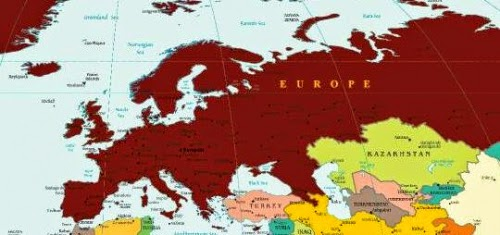
Dugin, like Putin, had a special love for Trump, who he called “the American Putin,” and he has special relationships with American neo-Nazi Richard Spencer and Trump advisor Steve Bannon. Dugin is a contributor to Spencer’s Alternative Right webzine.
Another source of this Dugin/Putin worldview is the Russian Orthodox Church, which promotes the ‘Russian World’ concept, according to which the peoples of the historic territory of ancient Rus are one, including those in Ukraine, Belarus and Moldova. At the third annual Assembly of the Russian World in November of 2009, Moscow Patriarch Kirill stated that “if we consider the Russian Federation with its present boundaries, then we have sinned against the historical truth and artificially cut off millions of people who are aware of their role in the fate of the Russian World.”
The global far-right and Putin
We will now review the global far-right’s connection to Putin’s regime; hopefully the next sections can be used as a handy guide when Putin supporters pedal out the argument that Putin is fighting “fascism” in Ukraine in the form of the 1000-strong Azov regiment.
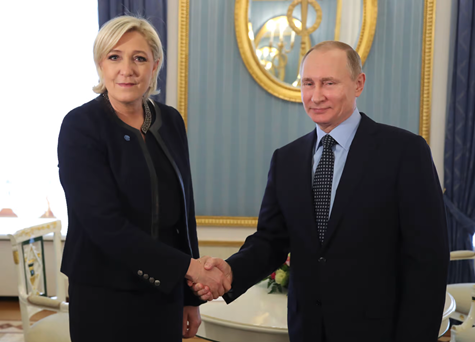
Following French National Front leader, Marine Le Pen’s, visit to Moscow in June 2013 at the invitation of State Duma, discussing “issues of common concern, such as Syria, EU enlargement, and gay marriage,” the Front supported the annexation of Crimea, stating that “historically, Crimea is part of Mother Russia.” She visited again in 2017. Her rival on the French far-right, Eric Zammour, reacted to Crimea by proposing a “Russian alliance, the only way to kill both the myth of federal Europe and to finally break away from the American protectorate.”
Similarly, the Nazi-like Jobbik party in Hungary called Putin’s fake Crimea referendum “exemplary.” Leader Gabor Vona visited Moscow in May 2013 at the invite of right-wing nationalists at Moscow State University, where he was hosted by Dugin. The Moscow visit was considered “a major breakthrough” which made “clear that Russian leaders consider Jobbik as a partner.” Bulgaria’s far right Ataka party similarly “insisted that Bulgaria should recognize the results from the referendum for Crimea’s joining to the Russian Federation.”
Not surprisingly, Putin’s Crimea ‘referendum’ – carried out after Russian military occupation forces staged a coup and placed in power the far-right ‘Russian Unity’ party that had received 4 percent of the vote at the previous Crimea elections – did not bother with many international observers. However, Russia did invite a few. Alongside observers from the French National Front, Jobbik and Attaka, the rest of the invitees list – Austrian Freedom Party, Belgian Vlaams Belang, Italy’s Forza Italia and Lega Nord, and Poland’s Self-Defense – reads virtually like a roll-call of the European far-right.
Other European far-right leaders have followed the National Front and Jobbik in their Moscow pilgrimages. In February 2017, three politicians of the German neo-Nazi Alternative for Germany (AfD) “flew to Moscow in a private jet paid for by the Russian government,” at a cost of some 25,000 Euro. This was not the only time Moscow was caught funding far-right parties; the French National Front has also been a recipient of Moscow cash which helped finance its 2014 election campaign.
Another far-right leader invited to Moscow by the State Duma, in March 2018, was Geert Wilders, of the arch-Islamophobic Dutch Party for Freedom (PVV). According to Wilders, “Vladimir Putin is a leader, whatever you think of him. … I applaud him as I applaud Mr. Trump for being leaders, who are standing there on behalf of the Russian and the American people … We lack that kind of leadership in Europe.”
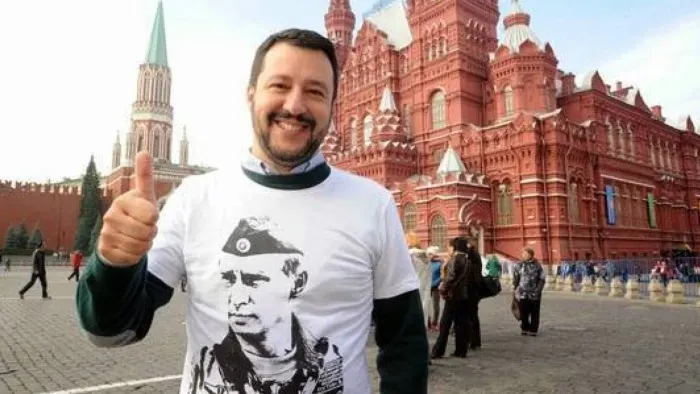
The Italian far-right is prominently allied to Putin. Mateo Salvini, head of the far-right Lega Nord (Northern League), signed a cooperation agreement with Putin’s United Russia Party in 2017; he is famous for wearing Putin T-shirts, and even brokered an oil deal with Russia to feed the League’s coffers. Putin lavished praise on Salvini during his 2019 visit to Italy, when Salvini attended a dinner in his honour. In March 2015, head of the neo-fascist Forza Nuova party, Roberto Fiore, attended the “International Russian Conservative Forum” in St Petersburg, along with the ‘League of Lombardy’, a Lega Nord front group, and the Duginite-fascist Italian party ‘Millennium.’
The St. Petersburg “Conservative Forum’ was also attended by the British National Party’s former leader Nick Griffin, the neo-Nazi Golden Dawn party of Greece, Udo Voigt from the German neo-Nazi National Democratic Party (NPD), Jared Taylor of the American Renaissance, former Ku Klux Klan lawyer Sam Dickson and various other fringe lunar rightists, along with Russian fascists led by the Putin-connected Rodina (Motherland) party and the Russian Imperial Movement. The Austrian Freedom Party and Serbian Radical Party were also invited but did not make it. The meeting “was adorned by a line from remarks Putin made in 2013 accusing Europe of backing away ‘from the Christian values at the foundation of European civilization’.”
The St. Petersburg forum launched a World National-Conservative Movement (WNCM), to which some 60 global fascist organisations were invited (full list here), an expanded version of the Alliance for Peace and Freedom (AFP), an existing pro-Putin alliance of 20 fascist parties, led by Fiore, Griffin and Le Pen. The AFP itself was invited into the WNCM; the dozens of other extreme right parties not only covered Europe and the US (including unabashed Nazis like the Nordic Resistance Movement, and the US Confederate League of the South), but also further afield, such as the South African white racist Front Nasionaal, the Nazi-inspired Syrian Social Nationalist Party, and Thailand’s viciously anti-democratic National Alliance for Democracy, the ‘Yellow Shirts’.
Alongside Griffin (by then head of the ‘British Unity” group) and the BNP, other British fascists invited were ‘Britain First’ and ‘UK Life League’. Meanwhile, in February 2020, Tommy Robinson, former head of the fascist English Defence League, visited Moscow to give a lecture in St. Petersburg about “The Rape of Britain” (ie, by immigrants, gays, liberals, the EU etc), though some former associates claim he was also looking for Moscow cash. During her own Moscow sojourn, British racist commentator Katie Hopkins declared that “Putin is not the big baddie the media have made him out to be, as she filmed pro-Putin videos from Russia. Putin puts Russia first. And his people love him for it. Far safer than Londonistan.” Not surprisingly, she was also a favourite of Trump.
The presence of Greece’s Golden Dawn – which explicitly displays Nazi symbols, and who sing the Greek version of the Nazi Party anthem – is hardly surprising, given the close alleged ‘historic’ connection between Russian and Greek fascism and ultra-conservative ideologies connected to Orthodoxy. Golden Dawn leader Michaloliakos even received a letter while in prison from Dugin, who “expressed support for Golden Dawn’s geopolitical positions.”
While US attendance at the St. Petersburg forum was limited to Taylor and Dickson, the US far-right is heavily pro-Putin; not for nothing did David Duke, former head of the Klan, live in Russia for five years (while there he sub-let his apartment to American neo-Nazi Preston Wigginton). Duke believes Russia is “the key to white survival.” In 2014, fellow white supremacist Richard Spencer, who believes Russia is the “sole white power in the world,” invited Dugin to a global conference of the far-right planned to be held in Hungary. Then there’s Matthew Heimbach, founder of the pro-Confederate Traditional Workers Party, who believes “Russia is the leader of the free world” while “Putin is supporting nationalists around the world and building an anti-globalist alliance.” As widely reported, American Rinaldo Nazzaro runs the neo-Nazi terrorist organisation The Base from a Russian apartment. In 2017, far-right commentator Ann Coulter declared that “In 20 years, Russia will be the only country that is recognizably European.” On the Christian fascist end, evangelist Pat Robertson declared that Putin had been “compelled by God” to invade Ukraine.
Just as the marchers at the white supremacist rally in Charlottesville in 2017 chanted “Russia is our friend,” so likewise at a recent white nationalist event in Florida organised by the America First Political Action Conference (AFPAC), racist Nick Fuentes prompted the crowd, “Can we get a round of applause for Russia?” The crowd responded by shouting: “Putin! Putin!”
Then there is the more mainstream, parliamentary, far-right, such as former US president Trump itself, whose Putin connections are well-known. As Ukraine exploded, Trump praised Putin as a “genius.” “Putin declares a big portion of Ukraine independent. Oh that’s wonderful. … How smart is that? And he’s gonna go in and be a peacekeeper. That’s the strongest peace force. We could use that on our southern border.” And of course there’s right-wing ideologue and former Trump advisor Steve Bannon, who recently declared “Putin ain’t woke” in an exchange with Blackwater founder, Eric Prince, who agreed that “The Russian people still know which bathroom to use;” and Trump’s Secretary of State and Christian rightist Mike Pompeo, who declared his “enormous respect” for the “talented statesman;” while Trump’s first National Security Advisor Mike Flynn claimed that after Biden “ignored and laughed at Putin’s legitimate security concerns … President Putin calculated this strategic, historic, and geographic play and made the decision to move.”
Trump loyalist and white supremacist Fox News host Tucker Carlson went full dog-whistle for Putin: “It may be worth asking yourself… why do I hate Putin.. Has Putin ever called me a racist? Has he shipped every middle-class job in my town to Russia? Did he manufacture a world-wide pandemic that wrecked my business and kept me indoors for two years? Is he trying to snuff out Christianity?”
Likewise in Europe, the parliamentary hard-right – to the extent we can distinguish them from the organisations above with genuinely fascist origins – are hard-line Putin’s supporters – from Hungarian Prime Minister Viktor Orban to Czech president Zeman, idiosyncratic neo-right populist Croatian president Zoran Milanovic, Serbia’s far-right Aleksander Vucic and his Serbian Progressive Party, and the Austrian government headed by Sebastian Kurtz, with ministers from the far-right Austrian Freedom Party. Likewise the close pro-Putin links of Nigel Farage and his Eurosceptic UK Independence Party.
This extends around the world, from Modi’s reactionary Hinduvsta regime in India to Brazil’s far-right Trump acolyte Bolsonaro. Both are allied to the US, while India is also geopolitically allied to Russia (above all, balance against China), but the Russia connection is also ideological in the case of its current far-right regime. In Brazil’s case, there is no obvious geopolitical connection to Russia, but Bolsonaro was more pro-Trump than pro-US, leading him into ideological alliance with Putin – Bolsonaro visited Putin on the eve of his invasion and declared he feels “deep solidarity with Russia.”
Fascism in the Donbass
But what of the Donbas? Putin is God to most fascists and Nazis the world over, but in Ukraine the only Nazis are anti-Russia Ukrainians, like Azov, right? In reality, as one source argues:
“On the whole, members of far-right groups played a much greater role on the Russian side of the conflict than on the Ukrainian side.”
Let’s look at some of this galaxy of ultra-nationalist, neo-Nazi, Orthodox-fascist and neo-Cossack parties and militia involved in the ‘separatist’ political and military leadership; of whom most are actual Russians, from Russia, rather than ethnic Russians from Ukraine.
We could start with the preamble to the constitution of the ‘Donetsk People’s Republic’ which calls for the “…establishment of a sovereign independent state, based on the restoration of a unified cultural and civilizational space of Russian World, on the basis of its traditional religious, social, cultural and moral values , with the prospect of becoming a part of “Greater Russia” as halo territories of the “Russian World”. This extreme Russian nationalist vision – in a region where Russians are not even a majority – is highlighted by its double-headed eagle flag – ie, the symbol of Tsarist Russia.
First let’s look at Russia’s leading mercenary gang, its equal to the US Blackwater – the Wagner Group, named by its founder after Hitler’s favourite musician. An extremely vicious militia, but are they fascists? Well, take a look at founder Dmitry Utkin. Pointing to the tattoos on his neck, Idrees Ahmad notes “Those are the Waffen SS rank insignia for a Hauptsturmführer (chief assault leader). And on his chest? That’s the Nazi Reichsadler (imperial eagle) badge.” A candidate to “de-Nazify” Ukraine?
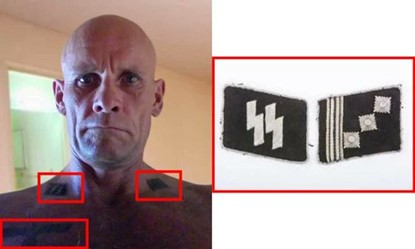
One far-right unit within Wagner operating in Donbas, known as Rusich, sports a logo featuring the ‘Slavic Swastika’ known as a Kolovrat; one Rusich account shows fighters holding a Valknut flag, which has been appropriated by white supremacists.
The first Russian militias in the Donbas were associated with the Russian National Unity party, a neo-Nazi organisation; here is its swastika logo. The DPR’s first ‘people’s governor’, and founder of the Donbas People’s Militia, Pavel Gubarev, was a member of the RNU. The RNU’s founder, Alexander Barkashov, previously led post-Soviet Russia’s first fascist organisation, Pamyat.
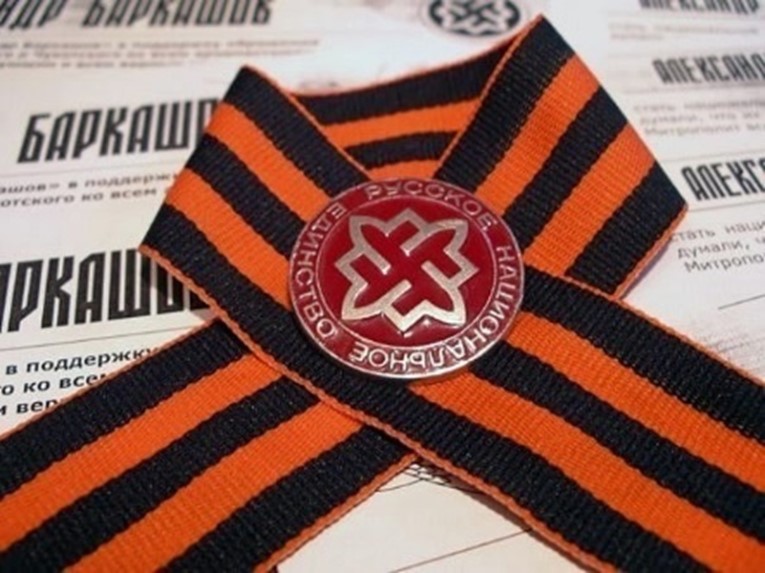
Gubarev has since joined the Duginite ‘Progressive Socialist Party of Ukraine’, led by Natalya Vitrenko, “a long-term associate of American right-wing extremist and anti-Semite Lyndon LaRouche.” Vitrenko stepped in to help in Donetsk after Gubarev was arrested.
RNU is closely associated with the clerical-fascist Russian Orthodox Army, led by Igor Girkin (Strelkov), the DPR’s first ‘minister of defence’. Its motto is ‘Warriors of the faith, brothers of the Great Russia, we will unite the whole Southeast’; they have been connected to serious crimes in Donbas, including murdering non-Orthodox civilians.
Another Russian fascist involved from the outset was the DPR’s first ‘prime minister’, Aleksander Borodai. In the 1990s, he worked for the newspaper Zavtra, run by idiosyncratic fascist Aleksander Prokhanov, who believed Russia was the mystical womb of Aryan civilisation. In 2011, Borodai and Prekhanov launched “Djen” TV, which promoted “anti-Semitism, Russian nationalism, conspiracy theories, homophobia, misogyny, denunciations of the decadence of European civilization, and treatises on the ‘fiction’ of a Ukrainian national identity.” Prokhanov praised Borodai as a true ‘White Russian nationalist’.
Another traditionalist-fascist militia is the neo-Cossack ‘Wolves’ Hundred’, founded during World War II by one ‘Shkuro’, later executed as a Nazi collaborator. According to one Russian ‘Cossack’ in the occupation of Slavyansk town hall in Donbas in 2014: “We don’t want Ukraine. Ukraine doesn’t exist for us. There are no people called Ukrainians. There are just Slav people who used to be in Kievan Rus, before Jews like Trotsky divided us.”
The violent monarcho-fascist Russian Imperial Movement , which aims to re-create the Russian empire and draws inspiration from the ‘Black Hundreds’ of Tsarist Russia, also trained and sent troops to Donbas. The RIM is associated with the most extremist Nazi-style groups in Europe, including the Nordic Resistance Movement and the German neo-Nazi NDP, who have trained in camps in Russia run by the RIM.
Then there is the neo-Nazi Russkii Obraz, promoted by Putin to ideologically outgun nationalist supporters of oppositionist Navalny. Obraz leader Ilya Goryachev “was a fervent supporter of the neo-Nazi underground, the skinheads who committed hundreds of racist murders in the second half of the 2000s.” In 2014, Obraz found a new home when Aleksandr Matyushin of Obraz “helped to terrorise supporters of the Ukrainian state in Donetsk” and became a major field commander.
Other far-right militia include the Interbrigades, connected to the Nazbol ‘Other Russia’ organisation, the Svarozhich, Rusich and Ratibor battalions, which sport the ‘Slavic swastika’, the Sparta Battalion, the Duginite Eurasianist Youth, the Nazi Slavic Union and the racist Movement Against Illegal Immigration.
For all the inevitable hatred between ultra-nationalist fascists in countries in conflict with each other, their similarity occasionally shows through. In July 2015, then DPR leader Alexander Zakharchenko praised Pravy Sector:
“The Right Sector rose and said: “Down with Poroshenko!” I began to respect them. I respect them for two moments: when gays were beaten in Kiev and when they tried to remove Poroshenko. I realized that the Right Sector are the same normal men.”
Various sections of Putin’s global far-right fan club have also fought in Donbas, including Falanga (Polish fascists), Orthodox Dawn (Bulgarian clerical fascists), Legion of St Stephen (Hungarian fascists aligned with Jobbik) and Jovan Šević Detatchment (Serbian Chetniks). While not fighting, the German neo-Nazi AfD has paid high-level visits to the Donbas ‘republics’.
According to Prospect Magazine:
“Various far-right Italian mercenaries and ultras (the country’s extremist football fans) are even fighting alongside Russian forces in Eastern Ukraine. Many of those combatants have made contact with a neo-Nazi organisation called Rusich, inspired by Pan-Slavism and a longing to recreate a 21st-century nationalistic version of the USSR. The exchange of personnel goes in both directions: in recent years various Italo-Russians have stood in local elections in Rome for Forza Nuova and another neo-fascist party, Fratelli D’Italia.”
Another Italian fascist group, Millennium, also fought in Donetsk, the group accused of charges “ranging from recruiting, training, and funding foreign mercenaries in Eastern Ukraine, to fighting alongside pro-Russia and nationalist extremists in the region.” Members of the French far-right ‘Eurasianist’ group Unité Continentale have also fought in Donbas.
Active global far-right support for Assad
Alongside the love of Putin generally, global fascism is also specifically enamoured to one of Putin’s major projects independently of Putin: in their support for Syria’s genocidal Assad regime. Everywhere in the world – in the US, everywhere in Europe, in Australia, various reactionary governments from India to Hungary – the far-right, fascists, Nazis, white-supremacists, far-right populists – almost unanimously support Assad.
This involves more than their connections to Putin, or to Assad’s allies in the Nazi-style Syrian Social Nationalist Party (established in the 1930s in admiration of Naziism, it displays its specific kind of swastika). Rather, the global far-right has lapped up Assad’s propaganda that he is fighting a war for civilisation against “Islamic terrorists” and “jihadists,” protecting Christians and minorities. Assad’s “war on terror”, like that of Israel, the US and Russia, is one global war the far-right fully identifies with.
Not surprisingly, both father and daughter Le Pen have been strongly pro-Assad. In 2012, Jean-Marie Le Pen stated that it was “not abnormal for the Syrian state to defend itself,” so Assad should not be criticised by countries who had fought Nazi Germany! Marine Le Pen in 2015 claimed that Assad is the only person who can rule Syria and save it from chaos. In 2016, former National Front youth leader Julien Rochedy visited Damascus to snap a selfie with his favourite tyrant.
In June 2013, a large delegation of European fascists visited Damascus to express support to the Assad dictatorship. According to Anton Shekhovtsov, the delegation included
- Bartosz Bekier, leader of the Polish fascist Falanga (which advocates stripping Polish Jews of their citizenship rights), and Mateusz Piskorski, member of the Samooborona (Self-Defence), Poland
- Frank Creyelman and Filip Dewinter of Vlaams Belang, Belgium
- Nick Griffin, leader of the British National Party, UK
- Roberto Fiore, leader of Forza Nuova (New Force), Italy
- Luc Michel, leader of the Parti Communautaire National-Européen and founder of the Eurasian Observatory for Democracy & Elections, Belgium
The delegation met the Speaker of the Syrian People’s Assembly, Mohammad Jihad al-Laham, and the Prime Minister Wael Nader al-Halqi.
Griffin, who declared that the Syrian opposition were “jihadi terrorists”, has continually expressed support for Assad, as has EDL founder Tommy Robinson, far-right British commentator Katie Hopkins (who also praises western propagandists for Assad such as Vanessa Beeley and ‘Partisan Girl’), and Nigel Farage, among other far-right British figures.
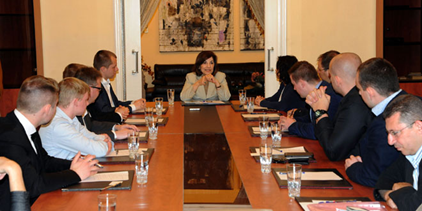
In 2016, Greece’s Golden Dawn MP Ioannis Sachinidis visited Syria and met parliament speaker Muhammad Jihad al-Lahham. Earlier, in 2013, the Greek neo-Nazi Black Lily (Mavros Krinos) claimed it had fighters in Syria supporting Assad, reportedly taking part in the regime’s conquest of Qusayr from the rebels. Black Lilly is a member of The European Solidarity Front, a coalition of far-right European parties “open to all those who love Syria, and support solidarity with President Assad, the Syrian nation and its army.” The neo-Nazi Skandinaviska Förbundet (Scandinavian League) has also sent fighters to Syria.
In early September 2013, an Italian delegation from the European Solidarity Front travelled to Damascus and Tartus “in support of the legitimate government of Bashar Al Assad and the Syrian people.” Alongside Forza Nuova, the delegation included the anti-immigrant CasaPound, “the fascist movement that has brought Mussolini back to the mainstream,” which in September 2015 invited the Syrian regime and the SSNP to its ‘International Congress of identity-solidarity’ in Rome. According to leader Simone Di Stefano, “Under the Assad regime, people can celebrate Christmas openly and women are not forced to wear a headscarf. Of course, we like the ideology of the Syrian state, but we also support what they represent.” In 2016, Forza Nuova chief Robert Fiore wrote that his fascist group “defends Assad and the Syrian people against attacks by ISIS and the USA,” in a post showing FN members holding a pro-Assad banner.
When in 2019, CasaPound visited Aleppo, the Syrian Ministry of Tourism tweeted the visit with the message “Syria is getting its tourism groove back.” CasaPound “expressed their pleasure to experience the fast restoration process and resilience & steadfastness of Syrian people.”

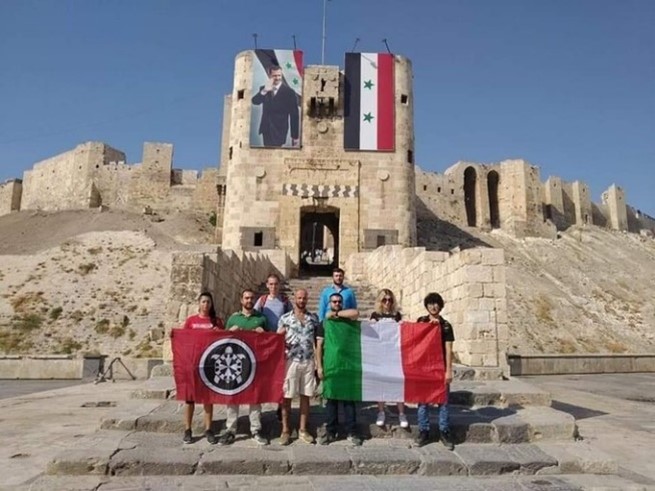
Udo Voigt, former leader of the neo-Nazi German NPD, took part in a 2016 Alliance of Peace and Freedom trip to Syria; on his return he noted that he “did not notice any oppression” and therefore “there is no reason to flee,” being an advocate of forcible return of Syrian refugees to Assad. The far-right AfD organised its own “fact-finding” trips to Syria in March 2018 and November 2019, feted by the regime, aimed at proving how “safe” Assad-land is for refugees to return to. The AfD has special links with Assad, via one Kevork Almassian, a Syrian who, curiously, sought asylum in Germany despite being a crazed Assadist, and was given a job in the AfD’s office.
In the US, Richard Spencer, has long argued for courting Assad, who he considers “a civilized person” and “source of stability in this chaotic world.” Even before the war, former Klansman David Duke delivered a speech in Damascus in 2005 on state television, claiming that his country, too, was “occupied by Zionists.” Consistent in his admiration, in March 2017 Duke declared “Assad is a modern day hero standing up to demonic forces seeking to destroy his people and nation – GOD BLESS ASSAD!”
During the 2017 white nationalist “Unite the Right” rally in Charlottesville, demonstrators proudly wore T-shirts advertising “Bashar’s Barrel Delivery Co.” The white supremacist James Fields who murdered Heather Heyer posted a portrait of Assad with the caption “UNDEFEATED.”
It is quite hard to find any on the US far-right that have not defended Assad, whether in the form of chemical war denialism, slanders of the White Helmets or more general praise for the alleged “defeater of jihadis,” from Alex Jones and his right-wing conspiracist ‘Infowars’, to far-right commentators Ann Coulter, Mike Peinovich , Fox and Friends host Steve Doocy, Tomi Lahren (who sought to remind Trump “that it’s America first”), and of course racist Tucker Carlson. While some mistakenly see Tulsi Gabbard as part of the “left”, in fact her praise for Assad comes from the same place as her strong Zionism, her love for the BJP and her claim to be a “hawk” on the drone wars – ie, right-wing Islamophobia.
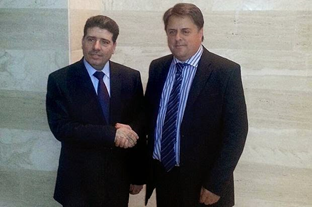

Of course, the more mainstream right-wing in the US and elsewhere, as opposed to ultra-rightists and fascists, is a mixed bag. While some on the right are anti-Assad because they are anti-Iran, or because they love US military power and see Assad as a convenient target, overwhelmingly rhetorical anti-Assadism was more prevalent among “liberal interventionist” voices in the Democratic Party, while the hard right tended towards the ‘Assad ain’t good but he’s better than the jihadists’ trope.
Trump was forthright pro-Assad in the lead-up to his election, and maintained that position until Assad betrayed him by using sarin gas, leading Trump to launch a theatrical strike which did close to zero damage to the Assadist military; Trump cut off all Obama-era aid to the Free Syrian Army and even to the civil opposition and ensured anyone backed by the US only fights ISIS. Ted Cruz held a similar position, Assad was bad but is the lesser evil to the Islamists he fights. His campaign manager, Dick Black, was more forthright pro-Assad, visiting Assad in Damascus twice. Black and Cruz are associated with the Christian right, many of whom see Assad as a saviour of Christians against “Islamic extremism.” Another hard reactionary, Rep. Dana Rohrabacher, also continually called for support to Assad (which didn’t prevent him being very anti-Iran). Then there is old reactionary and Trump ally Newt Gingrich who also reckons “both sides” are as bad as each other. Arch-warmonger John Bolton, whose main policy for 20 years was “attack Iran,” makes an exception with Syria, claiming regime change would result in “al-Qaida” coming to power. Then we have other reactionary neocons and Islamophobe extremists like Daniel Pipes, who penned “Support Assad” against the Islamists, and various ex-neocons like Leslie Gelb who turned to Assad as the shield against terrorism.
Putin, global fascism, Assad and the Israel connection
In 95 percent of the above cases of global far-right support to Assad, these parties, organisations and spokespeople also strongly support Israel and its war against the Palestinian people, for the same reason: Israel is another frontier state in the “war on terror”, a defender of western “civilisation” against “Islamic terrorism.” Given Israel’s nature as an apartheid state, it will be included here as part of the global far-right (as would apartheid South Africa if it still existed), but even for those who don’t accept this, there can be little doubt about the essentially fascistic character of the parties of the Israeli right: former prime minister Netanyahu’s Likud, and other parties of the secular, religious and settler right, such as those of current prime minister Naftali Bennett, and minister under both, Avigdor Lieberman.
Take for example Le Pen and the French National Front/Rally, the Austrian Freedom Party, the neo-Nazi AfD in Germany, Italy’s Lega Nord, Vlaams Belang of Belgium, Geert Wilders’ Dutch Party for Freedom, British National Party, English Defence League (EDL), Katie Hopkins (who called for the arrest of a grieving Palestinian mother whose baby had died from inhaling Israeli police tear gas) Nigel Farage, Orban, Bolsonaro, the US far-right in almost all its manifestations – are all absolutely pro-Israel, and usually favour the most hard-line Israeli policy against the Palestinians as practiced and peached by the Israeli hard-right (eg, support for the violently far-right Jewish Defence League by Le Pen and by the EDL –even the US government calls the JDL terrorist!).
Lega Nord leader Salvini has promised that, if elected, he would recognise Jerusalem as Israel’s capital, as has the German AfD and others. Indeed, just as the AfD has a ‘special relationship’ with Assad via Kevork Almassian, it has a special relationship with Israel via Netanyahu’s son, Yair Netanyahu; after he slammed the “evil” European Union as the enemy to Israel and “all European Christian countries,” he was held up as a “poster boy” by the AfD.
While this may seem problematic given the far-right’s traditional anti-Semitism, the majority the global far-right long ago switched from anti-Semitism to Islamophobia and see Israel, with its hard line against mostly Muslim Palestinians, as a model of the kind of hard anti-immigrant, militaristic ethno-state they fight for, part of their vision of a “Judeo-Christian” Europe “locked in a clash of civilisations against the Muslim world.” Of course, there are exceptions, but these are mostly just genuine throwbacks, actual Nazis or Klansmen (like David Duke), ie, the monkey fringe of the far-right. In any case, Israeli leaders, especially on the Likudnik and allied right, have little problem working with far-right governments and organisations which, despite their love for Israel, still entertain a degree of anti-Semitism.
Even some of the most unrepentant anti-Semites of the Naziesque far-right are concurrently pro-Israel, most prominently Richard Spencer, who describes himself as “a white Zionist,” calling Israel “the most important and perhaps most revolutionary ethno-state,” which he wants for “whites” in the US. He supported Trump’s recognition of Jerusalem as Israel’s “capital,” and was enthusiastic about Netanyahu’s “nation-state” law. He just doesn’t like “globalist” Jews who live in the US, which leads to “white people being dispossessed from this country,” unlike Israeli Jews “who understand [their] identity, who ha[ve] a sense of nationhood and peoplehood.” Not surprisingly, Spencer’s inspiration, Alexander Dugin, holds similar view: “the chief enemy of the Jewish tradition will come from its own house,” from “the mixed multitude, the assimilated people,” just as “in our own community, in a similar way, the chief enemy of the Russian nation are liberal Russians and not the representatives of other groups.” As in classical anti-Semitism, it is the “cosmopolitan” Jew that is the enemy, not the “traditional” Jew attached to the state of Israel.
This more or less total identity of western fascist support for Assad and Israel is not simply an odd parallel, but is ideologically consistent, support for two “frontlines” in their “civilisational” war against “radical Islam.” But in addition, there is a key connection between the two: the Putin regime, which while intervening in Syria to aid Assad’s victory has also cultivated excellent relations with the Israeli right.
From the moment Russia’s Syria intervention began in 2015, Putin and Israeli prime minister and Likud leader, Zionist extremist Benjamin Netanyahu, never stopped having high level meetings – Netanyahu met with Putin more than with any other world leader. In 2018, Netanyahu was one of only two world leaders standing next to Putin in Red Square commemorating the 73rd anniversary of the Soviet defeat of Nazi Germany, alongside Serbia’s Alexander Vucic. Netanyahu even produced a massive billboard showing himself with Putin for the 2019 elections. Not surprisingly, both partners were also enthusiastic allies of Trump. Under his rule, Israel authorized the ‘Cellebrite’ company “to sell its mobile phone hacking device to the Investigative Committee of the Russian Federation, which serves President Putin as a key tool of internal repression and political persecution in the country.”

Likewise, his equally ultra-rightist successor, and former ally, prime minister Naftali Bennett, was the first “world leader” to make a high level visit to Moscow to meet Putin. Bennett’s first statement following Russia’s invasion merely affirmed Ukraine’s right to sovereignty, but made no mention of Russia. Following US pressure, foreign minister and “moderate” Zionist Yair Lapid issued the official, half-hearted condemnation. But even then Bennett still refused to mention Putin or Russia in subsequent statements; he issued a demand that his ministers say nothing; rejected Ukraine’s calls for arms, and promised to block any attempt by Baltic states to send Israeli-made arms to Ukraine. His equally fascistic minister Lieberman later refused to condemn Russia following the Bucha massacre, claiming “I support first of all Israeli interests.” Earlier, Israel had blocked the US from providing Israeli ‘iron dome’ missile shield technology to Ukraine.
Israel refused the US request to co-sponsor a UN Security Council move to put a motion to condemn Russia to the General Assembly. Again this caused rebuke from Washington, so Israel voted in favour at the General Assembly, where it had no teeth. Bennett explained that Russia understood Israel’s forced stand, as Russia affirmed, promising that this would not affect their cooperation in Syria. Meanwhile, Netanyahu’s far-right Likud opposition criticises the government for saying anything at all, advising an even more “guarded” approach.
While Putin is one key link between Israel and the Assad regime (alongside the UAE-Bahrain-Egypt axis), Israel leaders are not shy about their own views. As Assad’s troops reconquered the south in 2018 as part of a Trump-Putin supervised deal, Netanyahu declared “We haven’t had a problem with the Assad regime, for 40 years not a single bullet was fired on the Golan Heights.” His Chief of Staff Lt. Gen. Gadi Eisenkot stressed that Israel will allow “only” Assad regime forces to occupy the Golan “border,” while his National Security Adviser, Meir Ben Shabat, declared that Israel has no problem with Assad as long as the Iranians leave. Fascistic defence minister Lieberman noted that from Israel’s perspective, “the situation is returning to how it was before the civil war, meaning there is a real address, someone responsible, and central rule,” as it “is also in Assad’s interest” to keep the occupied Golan “border” calm.
In other words, Israel always preferred Assad to prevail over the uprising; the alliance with Putin is not only because Putin’s air defence system in Syria allows Israel to bomb Iranian assets in the country (Russia and Iran both backed Assad’s victory but are now partially rivals over influence and spoils), as widely claimed.
Actually the Israel-Russia alliance precedes direct Russian intervention in Syria. During Israel’s Gaza blitzkrieg in 2014, Putin declared “I support the struggle of Israel,” while Israel refused to join its western allies in condemning the Russian annexation of Crimea, abstaining in the UN and rejecting sanctions.
Therefore, this alliance must be seen in its broader context: Israel’s own territorial aggression, violation of international law via annexation of other countries’ territory, and justification of occupation, aggression and commission of crimes of humanity on the basis that the Palestinian nation is a fiction, all strongly parallel Putin’s actions and ideological justifications. While allied to the US empire, Israel is a small-scale imperialist power in its own right with similar “revisionist” tendencies to Russia. There is a clear understanding of this affinity within the ruling elites of both countries.
The Ukrainian far-right versus the Russian far-right
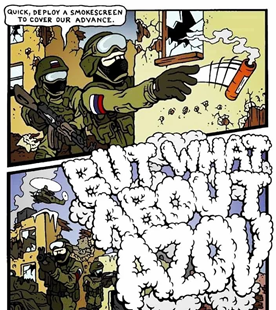
While the summary above demonstrates that the global far-right has been overwhelmingly pro-Putin and highlights the nonsense in Putin’s claim to want to “de-Nazify” anywhere, that is not to deny the presence of an aggressive far-right, fascist and Nazi sector among the political and military formations associated with Ukrainian nationalism.
On the one hand, the far-right – Svoboda, Right Sector and political representatives of Azov – collectively only received some 2.3 percent of the vote in the last Ukraine elections, so there is an extraordinary amount of demonisation in calling Ukraine some kind of “Nazi” cause, equivalent to the racist dubbing of freedom fighters in the Middle East – in Palestine, Syria and elsewhere – as “jihadis.”
On the other, the far-right – in particular the Azov regiment – has played a somewhat greater role on the military front since 2014, a common impact of military action which tends to empower tough guys and nationalists. The far-right Azov Battalion was formed in May 2014 by members of the ultra-nationalist Patriot of Ukraine gang and the neo-Nazi Social National Assembly, which had “engaged in xenophobic and neo-Nazi ideals and physically assaulted migrants, the Roma community and people opposing their views.” It gained a lot of initial support due to the relative disorganisation of official Ukrainian forces when suddenly confronted by the Russian intervention that year.
In November 2014, the government incorporated the Azov Battalion into the National Guard, as a means of controlling, or taming it; the government claims it can no longer act outside the discipline of the armed forces. While perhaps a dubious means, it did separate the armed forces from its political leadership. Ideological cadre including leader Andriy Biletsky had to leave Azov, as they allegedly were no longer able to do far-right work in the Ukrainian military, according to Alexander Ritzmann, a senior adviser at Berlin’s Counter Extremism Project. In 2016 Biletsky founded a far-right political party, National Corps. To get a taste of his views, in 2010 he had asserted that Ukraine’s mission should be to “lead the white races of the world in a final crusade against Semite-led Untermenschen.” Separated from his former militia, he set up the ‘Azov Circle’ civil movement and a new militia for internal repression, the National Druzhyna, formed in 2017 from veterans of the Azov Battalion. In January 2018, National Druzhyna “carried out pogroms against the Roma community and attacked members of the LGBTQ community,” under the guise of “restoring order.” These actions by the National Corps militia can easily be confused with the Azov regiment of the National Guard, but should be distinguished.
That doesn’t mean the Azov regiment is now free from fascist influence, but the reality is far from clear. In 2015, Andriy Diachenko, a spokesman for the regiment, claimed only 10-20 percent of regiment members are Nazis as regular non-ideological troops joined. According to Kacper Rekawek from the Center for Research on Extremism at the University of Oslo, “year by year, the connections (between the regiment and the movement) are looser.” While these claims may or may not be true, uniforms still sport the Nazi-like Wolfsangel symbol of the original battalion.
In 2018, US Congress passed a bill banning any US arms, training or assistance going to the Azov regiment.
Azov is therefore part of the problem, because its very existence as part of the Ukrainian armed forces is a bigger political problem than its small military reach as such; having a fascist-influenced regiment on the fronts is the best way to drive any ethnic Russians sitting on the fence into the hands of the far-right Russia-owned separatists. The Ukrainian government should indeed be criticised for not disbanding it or more fully severing its connections to the political movement.
However, the vast expansion of military action as a result of full-scale Russian invasion significantly reduces the relative weight of Azov and other fascists, given the “vast popular mobilisation” of millions of Ukrainians – including Russian-speakers – which “has risen up which goes far beyond the state apparatuses” to defend their country’s existence. The Azov regiment is estimated to consist of about 900 fighters; the standing Ukrainian armed forces are 196,000 troops, with another 900,000 reserves!
Regardless, Ukrainian fascists fighting Russia are virtually an anomaly in today’s global fascist climate. The appeals to global far-right solidarity by Ukraine’s Svoboda and Pravy Sector fell on deaf ears in 2014 following Ukraine’s Euromaiden. There was a history of connection between sections of the Russian and Ukrainian far-right before 2014; Svoboda had had observer status in the far-right Alliance of European National Movements (AENM). However, it had already been expelled in 2013, before the Euromaiden, at the initiative of Hungarian Jobbik, which objected to Svoboda’s anti-Hungarian statements.
In any case, in 2014, the AENM declared that the new Ukrainian government had no legitimacy and that it supports Russia’s annexation of Crimea. Most connections between the Ukrainian and European far right ended. “For Ukraine’s radical nationalists the problem with these old and new connections is that many, if not the majority, of Europe’s right-wing radical formations have sympathies for, or even contacts with, Putin’s Russia.” In discussing why previous links with Greece’s Golden Dawn were severed, Andre Tarasenko, Right Sector leader, noted “we cut it because they are with Putin who funds most far-right European parties, like Le Pen.”
On the military front, Azov has had a little more success, with several fascist groups that are anomalous among the far-right within their countries developing links. An article in Newsweek, before the invasion, titled ‘Ukraine’s War Draws U.S. Far-Right to Fight Russia’, claimed “neo-Nazi militias have recruited white supremacists from around the world to join their fight against Russia and advance racist ideology.” Yet the only groups mentioned were, in the US, the Nazi Atomwaffen Division (members of whom were deported from Ukraine) and the racist Rise Above Movement, clearly at odds with the strongly pro-Putin hegemony on the US far-right; Germany’s neo-Nazi Third Path (Der Dritte Weg), differentiating itself from the pro-Putin NPD and AfD; and Italy’s fascist CasaPound.
The idiosyncratic fascists of CasaPound may likewise want to distinguish their position from Forza Nuova, Lega Nord and other pro-Putin Italian fascists by supporting Ukraine, but in reality their position is more ambivalent; “some members of CasaPound have voiced their support for Ukraine in its war against Russia, while others support the Kremlin and have even fought on the side of pro-Russian militants in Eastern Ukraine.” CasaPound has participated in conferences with Azov in Lvov; but has also participated in rallies with other Italian fascists where “the crowd displayed posters hailing Putin as well as waving flags of the DNR” [Donetsk Peoples Republic], and organised a public meeting in Rome with Dugin. Explaining CasaPound’s vision of a new Italian-led Mediterranean, Simone Di Stefano, explained that “Outside the European Union and the Atlantic Alliance, Russia is a fundamental strategic ally for us … I very much appreciate the concept of ‘eternal Russia’ expressed in Dugin’s book.”
Impact of the Russian invasion on far-right support for Putin
The unexpected nature, ferocity and wide-ranging nature of Russia’s outright invasion of sovereign Ukraine has caused considerable anxiety for Putin’s far-right allies, from quite different perspectives. Although most remain cautiously supportive, some have expressed concern while others are torn between Russian and Ukrainian fascism.
On the one hand, the far-right parties that have some tendency towards “respectability,” due to participation in elections, have been humiliated by the sheer blatancy of Russia’s aggression. So, for example, French National Rally leader Le Pen, her rival Zemmour, Italian Lega Nord leader Salvini, Czech president Miloš Zeman and Hungarian prime minister Orban all had to condemn the aggression; though just days earlier they were still claiming the idea of invasion was just a beat-up and that Russia did have legitimate “security concerns”.
Condemning blatant aggression did make them partisans of Ukraine or born-again Russia hawks; rather, they tended to adopt the same position as the pro-Putin “left,” ie, of course we condemn the invasion, so let’s push for negotiations, compromise, no sanctions etc. Le Pen refused demands to destroy election pamphlets that prominently display her with Putin, explaining the invasion had only “partly changed” her view of him; Zemmour claimed that while “Putin is the guilty one, those responsible are in NATO which has not stopped expanding.” While Orban fell in with the EU and NATO consensus on the invasion, he stressed his opposition to sanctions or sending arms to Ukraine.
Some still entirely blame NATO with no criticism of Putin. For example, Alice Weidel, MP of the German fascist AfD, blamed the failure of the West to assure that Ukraine remained neutral rather than “continuously pushing the frontiers of NATO’s eastward expansion,” which was an “insult” to Russia’s great status. Dutch fascist Thierry Baudet of the misnamed Forum for Democracy claimed “Russia didn’t have much of a choice.”
On the other extreme, much of the more hard-line far-right have been attracted to Putin because he is seen as a firm and tough leader who is not scared to throw his weight around to defend “his nation”, “western civilisation” and the like. Hence their unanimous support for Putin’s backing of Assad’s dictatorship against “Islamists.” They feel none of the “respectable” pressures of the first group, but Putin’s invasion is a huge risk due to the stakes involved: an outright victory of Imperial Russia would greatly embolden the admiration he receives from global fascism, whereas a humiliating defeat could equally lead to a massive loss of support. With the Russian army bogged down, thousands of conscripts returning in body bags, the inability to yet conquer any major city, and the disastrous impacts of harsh western sanctions, humiliating defeat is not out of the question.
A third issue is the difficulty of choosing between equally attractive fascist partners. Azov appears to have had some success with its active promotional activities; “it is a larger-than-life brand among many extremists. It has welcomed Westerners into its ranks via white-supremacist sites. Azov stickers and patches have been seen around the globe.” This blends with right-wing oriented soldier-of-fortune types and various macho gun lovers and fascists who just want combat experience, including many who admit they are not going to fight for Ukraine, but for a pure white state, with Ukraine a useful springboard; from where they are in the West, it is simply easier to enter Ukraine to fight than to enter from the other side.
Combined with this is fascist uneasiness with two “white” nations at war. This can lend itself either to supporting Putin’s propaganda about Russians and Ukrainians being “one nation” divided by communists and globalists, or to opposing Putin launching aggression against fellow “whites.” Reportedly there has been discussion on far-right social media platforms about the role of “Jews” in driving two “white” nations to war.
To date though this has not led to a massive swing against Putin by the global far-right, rather confusion, division and nervous watching. Deutsche Welle reports that “some of Germany’s right-wing extremists have long had links to Ukraine’s neo-Nazi Azov militia. Other German neo-Nazis support Russia’s Vladimir Putin. … far-right activists who spent the past two years denouncing the German government and its restrictions to rein in the COVID pandemic, now place their hopes on Russia to champion their values: “When Putin marches through, men will again be men, electricity, and fuel will become cheaper, Islamization will end, and the greens and lefties will all be locked up,” read a chat group message of the ‘Free Thuringians’ extreme-right group. Similarly, the Washington Post reports that “the conflict has exposed a rift among extremists” in Germany, support divided between Russia and Ukraine. “A group called Free Saxony recently told its followers that the conflict was “largely fueled by NATO,” condemning smear campaigns against “friends of Putin.”
Thus, despite various articles with headings like Far right militias in Europe plan to confront Russian forces, concrete evidence is slim. This article reports that “in recent days, militia leaders in France, Finland and Ukraine have posted declarations urging their supporters to join in the fight to defend Ukraine against a Russian invasion” and that “numerous far-right white nationalist and neo-Nazi groups throughout Europe and North America had expressed an outpouring of support for Ukraine, including by seeking to join paramilitary units in battling Russia,” while naming very few.
The most concrete example was from Finland: “Neo-Nazi and white supremacist Telegram users from Finland also encouraged fellow Finns to join the fight alongside Ukrainians … One post said, “the age-old duty of the Finns has been to wage war against the Russians.” But that’s unsurprising – Finland was invaded and occupied by the Russian Empire, and then again by Stalin, leading to Finnish alliance with Nazi Germany against Russia, ie, like Ukraine, there is a history of national conflict with Russia which leads extreme nationalists into conflict with that country.
On the whole, therefore, while the edifice of Putin’s global alliance with fascism has been under strain from opposing pressures, there has been no drastic change to date. A complete Russian victory would almost certainly solidify the alliance and lead to an enormous surge in support for Kremlin-backed and financed fascist and far-right movements globally. In contrast, a humiliating Russian defeat would possibly lead to desertion of a weakened Russia by many fascist groups, and conversely, their long association with Putin, their heralding of him as the great white saviour, may discredit many of these groups and lead them to lose support. This is one more, not unimportant, reason to hope for the defeat of Putin’s bloody gamble in this fascistic far-right version of late 19th century imperialism.
First published on Michael Karadjis’s blog.


Leave a Reply